Everyday, Handmade…
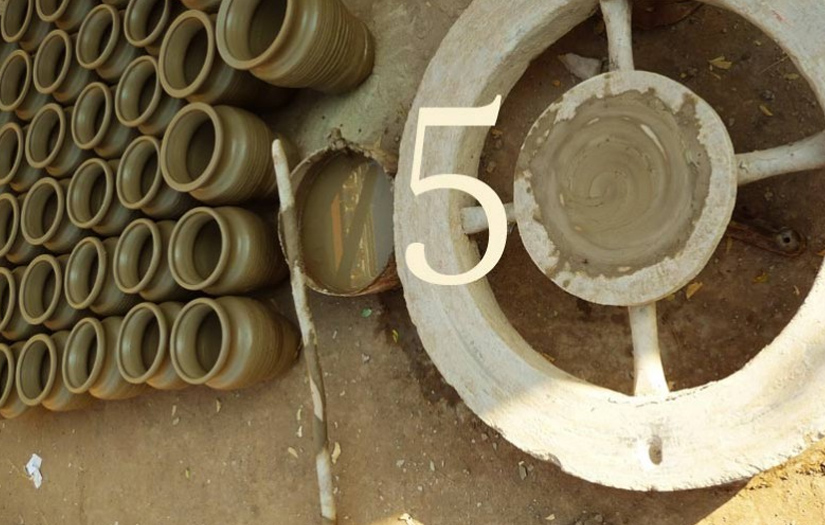
Today we craft our 50th tale …. We hope that in the past 49 we could for least momentarily transpose our audience in the artisans ‘life & style’…that you…..our readers, even if for fleeting moments, have ‘dwelled in’ and felt a connection with these craft traditions.
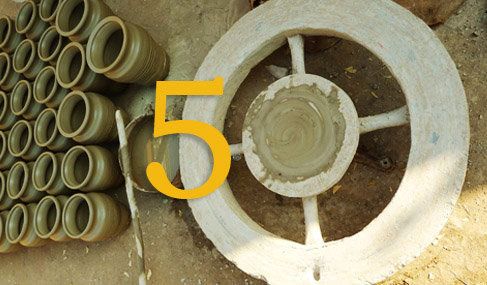
We (un)covered many a crafts, some pristine and intact, untouched by time, many changing, transforming, soaking in new forms, new meanings, new materials and uses…and some nascent completely new ones ….born of our new urban contexts… new urban needs…new urban materials… yet engaging the skill of hand and the ingenuity of the artisan all the same.

However as we marvel at the grandeur of this rich evolving craft heritage, we pause a bit at this 50th beacon of a post. We pause and ponder that while“silks and ivory, and gems and jewelry, embroidered goods, a sword’s zing and a blacksmith’s kiln” are all in our previous posts what is amiss is the seemingly mundane. We now reflect on the unsung daily crafts… those everyday objects that are so for-granted in the land’s daily chores that they often don’t get their due attention.
From an earthen diya lit in a shrine to a humble broom that keeps its premises clean, at times a produce of handicraft touches our lives in ways we don’t even notice.
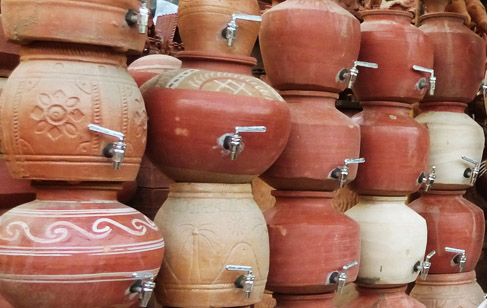
One of the earliest products of handicraft, the earthen pot, or ‘matka’, finds its way from distant desert wells, to city streets and restaurants. Potters everywhere, in villages and metropolises, make earthen pots on the wheel for quenching the thirst of millions.
Even within the simple need of storing drinking water the earthen pot finds literally thousands of manifestations across the land from the slender long necked ‘surahi’ to the near spherical ‘garvi’. The potters however also make numerous other artefacts, like lamps, coin banks, toys, chimes and birdfeeders, each with a unique expression, and each with an answer to a daily need.

Like the matka, the bamboo basket is another such day to day object of utility. Baskets too like earthen pots are made across the length and breadth of the country with literally thousands of design variations… changing form from region to region… For instance, Pathu haversacks of Arunachal Pradesh are known for their double weave and waterproof construction, lent by the agility of split cane and a layer of palm leaves in between, while the Jhakoi fish traps of the neighbouring Assam, that are made by moulding bamboo split mats, have an open, yet strong weave.
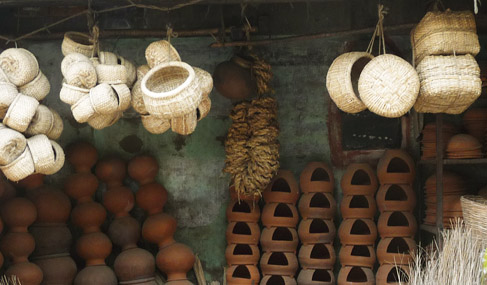
Craftsmen weave strips of bamboo into any shape imaginable, making baskets, trays and sieves, and miniatures of the same for children. Basketry has a sheer variety of scale, from thumb sized decorative knick knacks to the circular river boats; craftsmen put just this one material, bamboo, to its finest possibilities and biggest tests of strength. Tight twill weaves for storage containers, long, brick like weaves for baskets and open, hexagonal weaves for the more decorative ones… This simple craft of bamboo weaving, a native of the villages, now finds its niche in sustainable interior design.
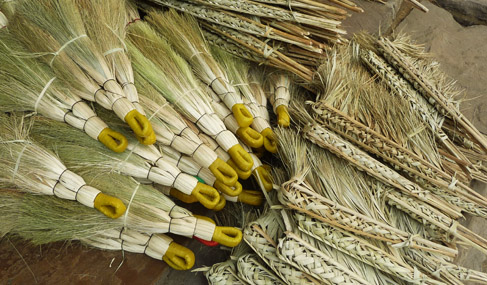
Bamboo has also been one of the main materials in brooms.Traditionally, bamboo strips or grass are used to make the bristles which are tied together at one end with a rope. The kinds of grass used in brooms differ in every region, as per the surrounding geographical environment. People even use date leaves or coconut leaves, whichever is available around, to make brooms. Handmade from start to finish, the broom now sees new forms with plastic handles or bristles.
Not just objects of basic utility, but also those of personal adornment, have been handcrafted with varying levels of skill and aesthetic. Ancient civilizations made jewellery out of beads and it seems that this fascination with the tiny little drops of colour is eternal. Sitting outside gold laden jewellery shops, artisans string beads of different colours and sizes, of glass and plastic and metal, with shiny threads fulfilling small wishes of many.
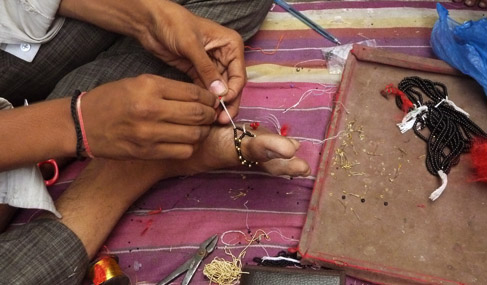
Ever wondered who makes those pretty tassels dangling behind a necklace or from strings that tie small pouches..? Or who makes colourful strings that the tassels hold on to? Is it the man who sits quietly at the corner of the crowded lanes of the old city? Or is it the woman who sits cradling her baby on a hot summer afternoon, in her house in a remote village?
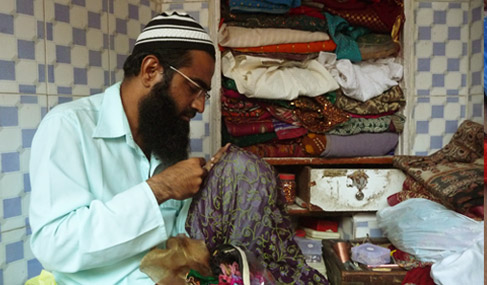
Looking through thick, hazy spectacles, hunching over a piece of torn fabric, an old man slowly and carefully mends a hole with fine threads and brings the garment back to life. A skill passed on through generations, not many today’s age are able to learn with the same flawlessness. Darning, locally known as “ruffu”, might not be a handicraft that results in a complete object, but then it’s an art not of creation but of healing.
Another healer, the roadside local cobbler, not just knows how to repair shoes, but is also skilled in making different kinds of footwear. In many villages still, with simple tools, threads and nails, shoemakers make most hardy shoes that weather for years. Such is the resourcefulness of these craftsmen that some even use old tires to make footwear soles.
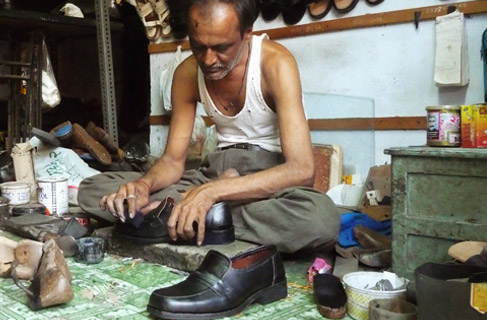
With time, crafts and their makers have also adapted to new materials and technologies. Like an expert caricaturist, the artisan at the marketplace bends and turns a single piece of plastic covered wire to make miniature cycles, chairs, umbrellas and many such delightful curiosities. Next to him, the firki seller makes miniature windmills with simple yet careful twists of shiny coloured paper connected to a stick, and sprinkles color onto busy crossroads. As vehicles gush past a wall of spinning firkis, a glittery flutter starts, like hundreds of butterflies twirling and dancing…
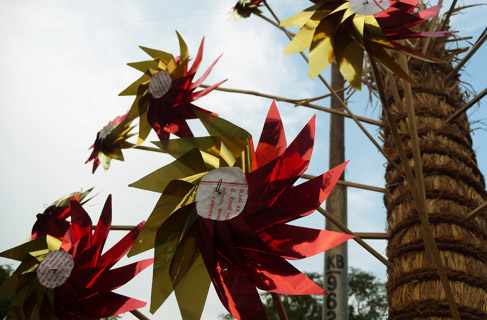
These matkas, tokris, jhadus and firkis are only a few of the objects that are seemingly mundane yet deeply entwined with the daily lives of the people. Such produce is perhaps the FMCG equivalent of the handicrafts sector. This is the very notion that Gandhi spoke of, that it wont merely suffice to conjure up an ecosystem to sustain crafts merely as a tourist curiosity or as exotic export items. The real strength lies in reviving the ‘make local’ and ‘consume local’ culture…when these objects suffice our daily needs on a sustained basis ….
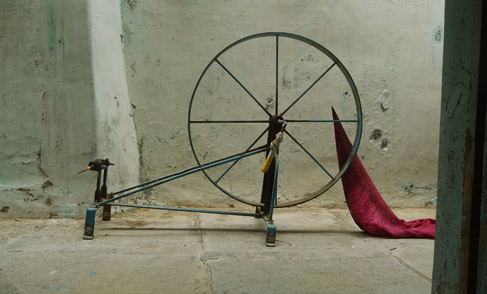
where we all understand the long-term benefits of such rooted local source – make – buy – consume economics. Thus we the ‘consumers’ really have the last say next time we buy household goods… are we for the local benevolent creating hand? …or are we for the distant smoking chimneys?










